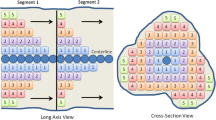Abstract
In current methods of computer-aided detection (CAD) of colonic polyps, curvature-based shape measures, like the shape index, curvedness, sphericity ratio, Gaussian curvature, mean curvature, etc., are widely used to analyze the local shapes in the colon wall. Therefore, the curvature estimation is an essential step, which is often conducted through kernel methods. However, spurious calculations indicating high curvature are frequently observed when the kernel contains two surfaces (this happens for objects like a thin slab, sphere, etc.). In this study, we adapted the Knutsson mapping method to solve this problem, so that we can improve the curvature estimation for CAD of colonic polyps in virtual colonoscopy.
Access this chapter
Tax calculation will be finalised at checkout
Purchases are for personal use only
Preview
Unable to display preview. Download preview PDF.
Similar content being viewed by others
References
American Cancer Society. Cancer Facts & Figures 2008. American Cancer Society, Atlanta (2008)
Summers, R., Yao, J., Pickhardt, P., Franaszek, M., Bitter, I., Brickman, D., Krishna, V., Choi, R.: Computed tomographic virtual colonoscopy computer-aided polyp detection in a screening population. Gastroenterology 129, 1832–1844 (2005)
Monga, O., Ayache, N., Sander, P.T.: From voxel to intrinsic surface features. Image and Vision Computing 10(6), 403–417 (1992)
Thirion, J.P., Gourdon, A.: Computing the differential characteristics of isointensity surfaces. Computer Vision and Image Understanding 61(2), 190–202 (1995)
Summers, R., Beaulieu, C., Pusanik, L., Malley, J., Jeffrey, R., Glazer, D., Napel, S.: Automated polyp detector for CT colonography: feasibility study. Radiology 216, 284–290 (2000)
Yoshida, H., Nappi, J.: Three-dimensional computer-aided diagnosis scheme for detection of colonic polyps. IEEE Transactions on Medical Imaging 20(12), 1261–1274 (2001)
Wang, Z., Liang, Z., Li, L., Li, X., Anderson, J., Harrington, D.: Reduction of false positives by internal features for polyp detection in CT-based virtual colonoscopy. Medical. Physics 32(12), 3602–3616 (2005)
Konukoglu, E., Acar, B., Paik, D., Beaulieu, C., Rosenberg, J., Napel, S.: Polyp enhancing level set evolution of colon wall: method and pilot study. IEEE Transactions on Medical Imaging 26(12), 1649–1656 (2007)
van Wijk, C., van Ravesteijn, V.F., Vos, F.M., van Vliet, L.J.: Detection and segmentation of colonic polyps on implicit isosurfaces by second principal curvature flow. IEEE Transactions on Medical Imaging 29(3), 688–698 (2010)
Wang, S., Zhu, H., Lu, H., Liang, Z.: Volume-based feature analysis of mucosa for automatic initial polyp detection in virtual colonoscopy. International Journal of Computer Assisted Radiology and Surgery 3(1-2), 131–142 (2008)
Zhu, H., Duan, C., Pickhardt, P., Wang, S., Liang, Z.: Computer-aided detection of colonic polyps with level set-based adaptive convolution in volumetric mucosa to advance CT colonography toward a screening modality. Cancer Management and Research 1(1), 1–13 (2009)
Zhu, H., Fan, Y., Lu, H., Liang, Z.: Improving initial polyp candidate extraction for CT colonography. Physics in Medicine and Biology 55, 2087–2102 (2010)
Zhu, H., Liang, Z., Pickhardt, P., Barish, M., You, J., Fan, Y., Lu, H., Posniak, E., Richards, R., Cohen, H.: Increasing computer-aided detection specificity by projection features for CT colonography. Medical. Physics 37(4), 1468–1481 (2010)
Campbell, S., Summers, R.: Analysis of kernel method for surface curvature estimation. International Congress Series 1268, 999–1003 (2004)
Rieger, B., Timmermans, F.J., Van Vliet, L.J., Verbeek, P.W.: On curvature estimation of ISO surfaces in 3D gray-value images and the computation of shape descriptors. IEEE Transactions on Pattern Analysis and Machine Intelligence 26(8), 1088–1094 (2004)
Lipschutz, M.: Differential Geometry. McGraw-Hill (1969)
Author information
Authors and Affiliations
Editor information
Editors and Affiliations
Rights and permissions
Copyright information
© 2011 Springer-Verlag Berlin Heidelberg
About this paper
Cite this paper
Zhu, H., Fan, Y., Liang, Z. (2011). Improved Curvature Estimation for Shape Analysis in Computer-Aided Detection of Colonic Polyps. In: Yoshida, H., Cai, W. (eds) Virtual Colonoscopy and Abdominal Imaging. Computational Challenges and Clinical Opportunities. ABD-MICCAI 2010. Lecture Notes in Computer Science, vol 6668. Springer, Berlin, Heidelberg. https://doi.org/10.1007/978-3-642-25719-3_2
Download citation
DOI: https://doi.org/10.1007/978-3-642-25719-3_2
Publisher Name: Springer, Berlin, Heidelberg
Print ISBN: 978-3-642-25718-6
Online ISBN: 978-3-642-25719-3
eBook Packages: Computer ScienceComputer Science (R0)




